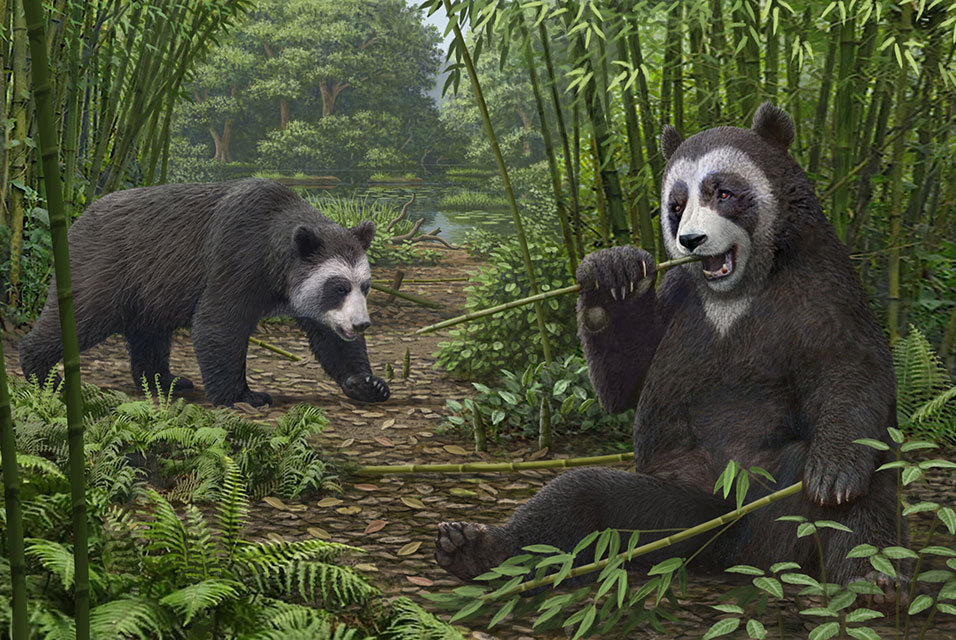LOS ANGELES, CA.- When is a thumb not a thumb? When it's an elongated wrist bone of the giant panda used to grasp bamboo. Through its long evolutionary history, the panda's hand has never developed a truly opposable thumb and instead evolved a thumb-like digit from a wrist bone, the radial sesamoid. This unique adaptation helps these bears subsist entirely on bamboo despite being bears (members of the order Carnivora, or meat-eaters). In a new paper published in Scientific Reports, the
Natural History Museum of Los Angeles County's Curator of Vertebrate Paleontology Xiaoming Wang and colleagues report on the discovery of the earliest bamboo-eating ancestral panda to have this "thumb." Surprisingly, it's longer than its modern descendants.
While the celebrated false thumb in living giant pandas (Ailuropoda melanoleuca) has been known for more than 100 years, how this wrist bone evolved was not understood due to a near-total absence of fossil records. Uncovered at the Shuitangba site in the City of Zhaotong, Yunnan Province in south China and dating back 6–7 million years ago, a fossil false thumb from an ancestral giant panda, Ailurarctos, gives scientists a first look at the early use of this extra (sixth) digit–and the earliest evidence of a bamboo diet in ancestral pandas–helping us better understanding the evolution of this unique structure.
"Deep in the bamboo forest, giant pandas traded an omnivorous diet of meat and berries to quietly consuming bamboos, a plant plentiful in the subtropical forest but of low nutrient value," says NHM Vertebrate Paleontology Curator Dr. Xiaoming Wang. "Tightly holding bamboo stems in order to crush them into bite sizes is perhaps the most crucial adaptation to consuming a prodigious quantity of bamboo."
How to walk and chew bamboo at the same time
This discovery could also help solve an enduring panda mystery: why are their false thumbs so seemingly underdeveloped? As an ancestor to modern pandas, Ailurarctos might be expected to have even less well-developed false"thumbs," but the fossil Wang and his colleagues discovered revealed a longer false thumb with a straighter end than its modern descendants' shorter, hooked digit. So why did pandas' false thumbs stop growing to achieve a longer digit?
"Panda's false thumb must walk and 'chew'," says Wang. "Such a dual function serves as the limit on how big this 'thumb' can become."
Wang and his colleagues think that modern panda's shorter false thumbs are an evolutionary compromise between the need to manipulate bamboo and the need to walk. The hooked tip of a modern panda's second thumb lets them manipulate bamboo while letting them carry their impressive weight to the next bamboo meal. After all, the "thumb" is doing double duty as the radial sesamoid–a bone in the animal's wrist.
"Five to six million years should be enough time for the panda to develop longer false thumbs, but it seems that the evolutionary pressure of needing to travel and bear its weight kept the 'thumb' short–strong enough to be useful without being big enough to get in the way," says Denise Su, associate professor at the School of Human Evolution and Social Change and research scientist at the Institute of Human Origins at Arizona State University, and co-leader of the project that recovered the panda specimens.
"Evolving from a carnivorous ancestor and becoming a pure bamboo-feeder, pandas must overcome many obstacles," Wang says. "An opposable 'thumb' from a wrist bone may be the most amazing development against these hurdles."









